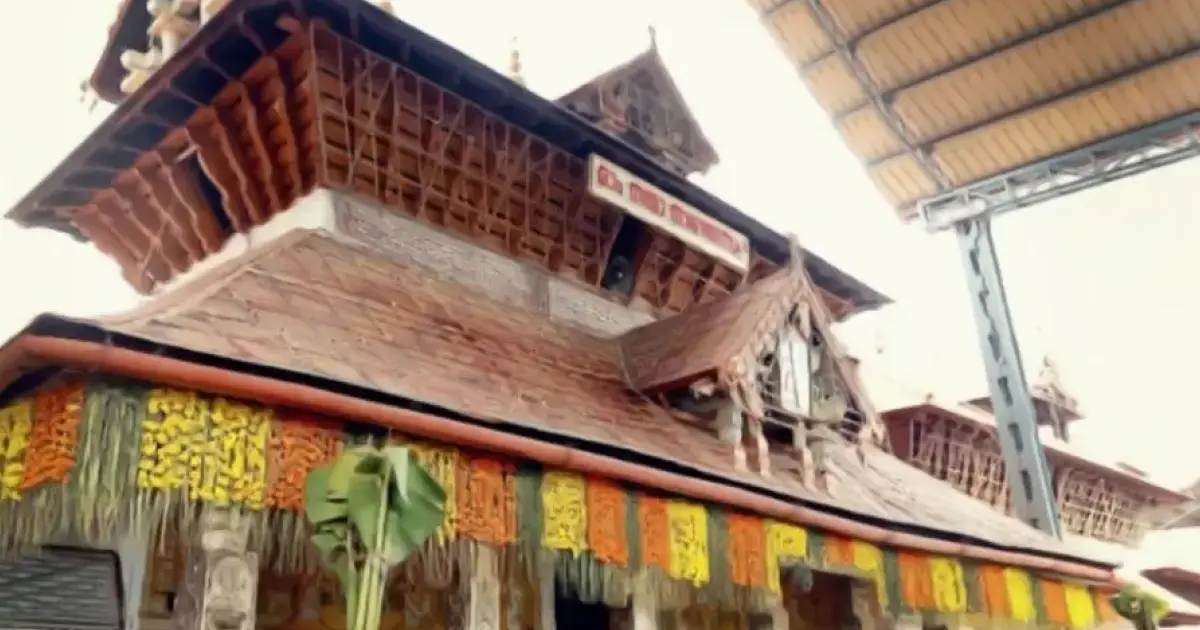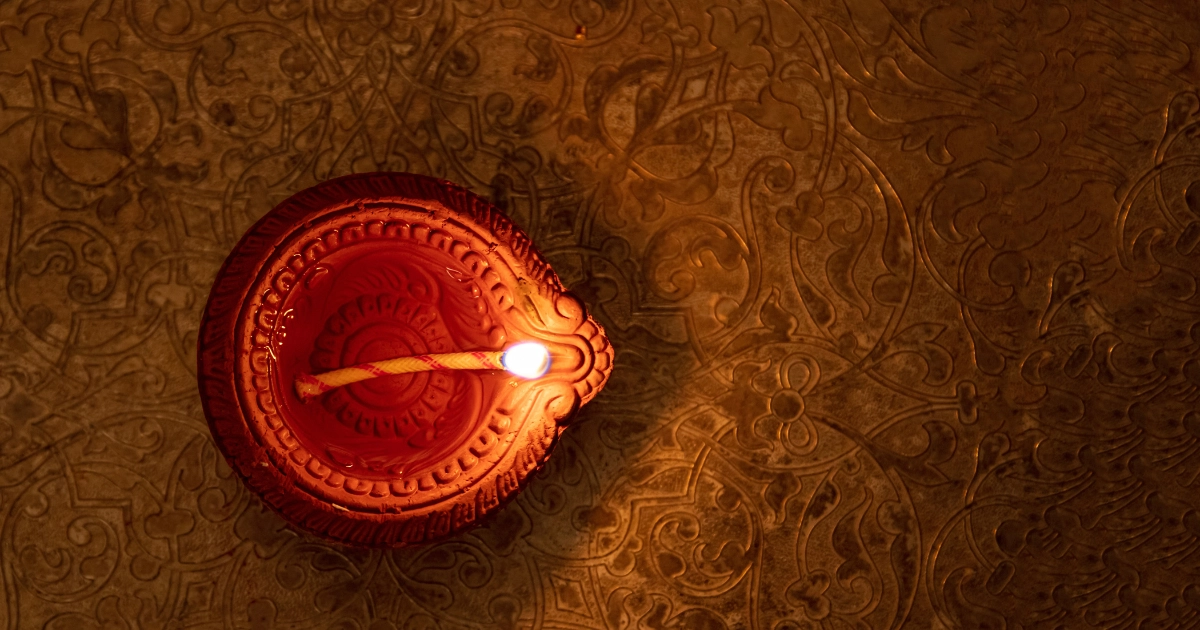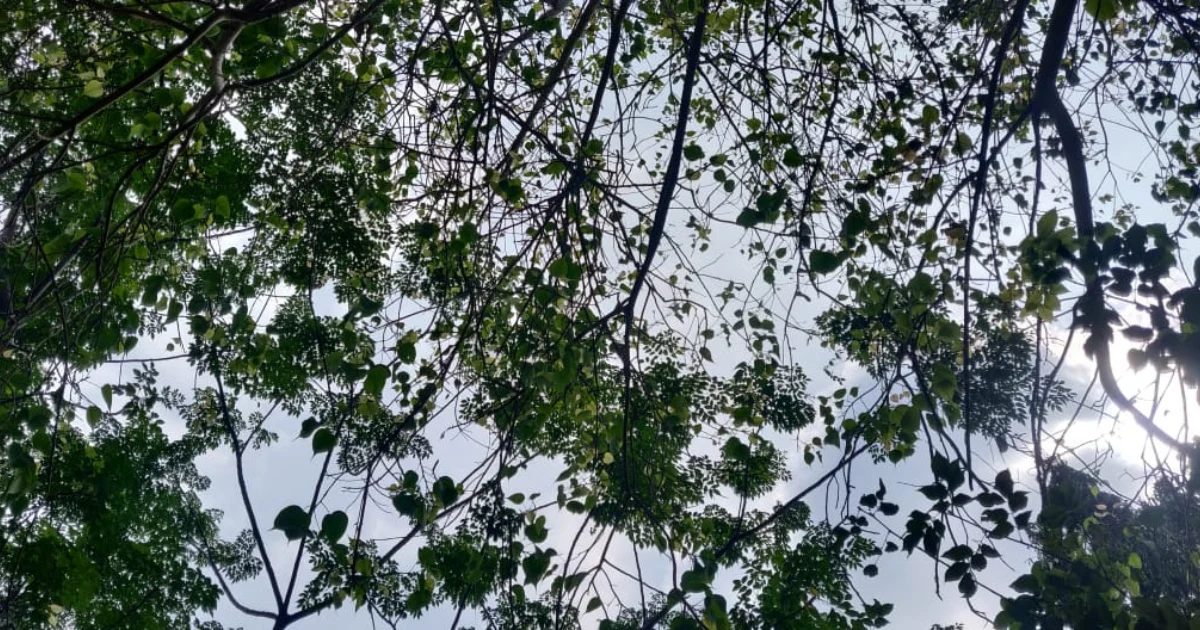सान्द्रानन्दावबोधात्मकमनुपमितं कालदेशावधिभ्यां
निर्मुक्तं नित्यमुक्तं निगमशतसहस्रेण निर्भास्यमानम् ।
अस्पष्टं दृष्टमात्रे पुनरुरुपुरुषार्थात्मकं ब्रह्म तत्वं
तत्तावद्भाति साक्षाद् गुरुपवनपुरे हन्त भाग्यं जनानाम् ॥
नारायणीयम् १.१ ॥sāndrānandāvabodhātmakamanupamitaṃ kāladeśāvadhibhyāṃ
nirmuktaṃ nityamuktaṃ nigamaśatasahasreṇa nirbhāsyamānam
aspaṣṭaṃ dṛṣṭamātre punarurupuruṣārthātmakaṃ brahma tatvaṃ
tattāvadbhāti sākṣād gurupavanapure hanta bhāgyaṃ janānām ||
Nārāyaṇīyam 1.1 ||
We have heard Śrī Guruvāyūrappan's story several times. There is also sufficient evidence and writing on His form being the Divine Healer.
Why so, we wonder?
Afterall, Śrī Kṛṣṇa has so many forms in so many places - the playful child, the charming youth, the insightful leader, the passionate lover and so many more! Why does this form then derive its essence from Guru (Bṛhaspati) and Vāyu devatā?
There definitely has to be a deeper reason behind this, as no deity forms are taken in a random fashion. The symbolism and context in which the deity emerges is usually very deeply intertwined.
Let us set out to explore the deeper meaning behind this deity, with some preliminary thoughts. The inquiry begins with a question: Why is Guruvāyūrappan known as the healer, and how does this apply to ourselves?
Śrī Guruvāyūr Mahākṣetra - A Glimpse
Śrī Guruvāyūr Mahākṣetra stands at the very center of Kerala desam's kṣetra-māhātmyam. Although, the form is that of caturbhuja Śrī Mahā Viṣṇu as we will discover ahead, He is worshiped as Unnikṛṣṇa or Unnikannan ~ the young Śrī Kṛṣṇa who delights all our hearts with His supreme līlās. Today, on the occasion of Śrī Kṛṣṇa Janmāṣṭamī, as we awaken to the presence of Śrī Unnikṛṣṇa in the cave of our hearts, we contemplate upon Him as the one who heals and uproots the spiritual obstacles within us that keep us from attaining union with Him.
Śrī Guruvāyūrappan, evokes many bhāvas in the hearts of his bhaktas. Thousands flock at all times of the day to His kṣetra, which attracts the largest of crowds in all of Keralam, with the longing of receiving but one glimpse of their beloved deity. For a bhakta, this fleeting moment of darśana marks the fulfillment of his saṅkalpa, culminating in an overwhelming surge of bhakti in his hṛdaya-kamalam.
Multiple accounts from bhaktas further affirm the Lord's role as the ultimate healer, the foremost amongst them being the story of Melputhur Śrī Nārāyaṇa Bhaṭṭāthirī. While we will explore Bhagavān's līlās in future articles, today it shall suffice for us to understand that Melputhur, an erudite scholar, arrived at Guruvāyūpuram whilst suffering from immense rheumatic pain.
As his upāsana to the devatā, he composed the renowned and classical Nārāyaṇīyam in a span of 100 days, thereby condensing within the daśakams, the very essence of Śrīmad Bhāgavatam. He concludes this great composition in praise of his beloved Śrī Guruvāyūrappan with the words - āyurārogya soukhyam and is not only cured of his disease, but is blessed with the everlasting nectar of Śrī Kṛṣṇa bhakti.
The stories of Guruvāyūr find place in the Śrīmad Bhāgavatam, Keralākṣetra Māhātamyam and the Keralācāradīpikā. The Koka saṅdeśa kāvya also describes briefly golden flag staff of the Guruvāyūr kṣetra, fluttering in the air and the majestic gopuram piercing the skies. The Bhramara and Cakora saṅdeśa kāvyas assigned to periods earlier than 1422 AD, describe Śrī Guruvāyūrappan as the Great Healer.
The temple has also historically survived many devastating incidents. During the Islamic raids, the mūlavigraha was buried underground while the utsava vigraha was carried to reside in safety at Ambalapuzha Śrī Kṛṣṇa kṣetra. In 1970, during the iconic ekādaśī festival, the temple was gutted by a massive fire destroying much of the sacred complex. However, the vigrahas of Śrī Guruvāyūrappan, Śāstā and Bhagavatī miraculously remained unharmed and were drawn to safety. The Guruvāyūr kṣetra that we fervently visit today remains as enthralling and continues to be rightfully called as bhūloka Vaikuṇṭham ~ the earthly abode of Śrī Mahā Viṣṇu.
Śrī Guruvāyūrappan - The Story
The Guruvāyūr kṣetra itself is a sacred space, made so through the consciously intentional saṅkalpa and presence of auspicious ones. In the days of yore was famed rājā Prācīnabarhi, with his ten sons known as the Pracetas. As per his responsibility, rājā Prācīnabarhi wanted to ensure the continuation of his lineage. He thus sent his ten sons to perform tapas, difficult austerities, in a sacred place known as Rudra Tīrtha. This holy lake later came to form the current day Guruvāyūr mandir’s tank, or puṣkariṇī. The Śrīmad Bhāgavatam refers to the Rudra Tīrtha to be as wide as the great sea and as pure as the elevated mind of the sage.
As the Pracetas approached Rudra Tīrtha for their tapas, Bhagavān Śiva was already meditating there - on Śrī Viṣṇu only - underneath the sacred surface. Śivji came to the surface to greet the bright and pleasant looking ten young sons. Of course, He knew their intention and was gladdened by their bhakti, their devotion. He blessed them by teaching them the Rudra Gītā. We know this hymn today as given in Śrīmad Bhāgavata Purāṇa, and it is one of the most beautiful praises of Śrī Viṣṇu. Bhagavān Śiva also blessed the Pracetas with assurance that rājā Prācīnabarhi’s responsibility would be fulfilled, and thus resumed underneath the surface of the lake to continue his own dhyāna.
Having been blessed as such, the Pracetas then began their tapas. They began worshiping Śrī Viṣṇu, standing in the tank, and went on for ten thousand years until Śrī Viṣṇu Himself blessed them with darśana. Śrī Viṣṇu also assured them that they would have a noble son, whose children would fill all the three worlds.
In such purified kṣetra was the Guruvāyūrappan temple later established.
Next, the powerful and age-old mūrti, the vigraha or image, itself. This mūrti was originally worshiped by Mahā Viṣṇu Himself, in his celestial abode Vaikuṇṭha. The murti is of the beautiful four-armed Śrī Viṣṇu, or caturbhuja rūpa. This murti was given by Śrī Viṣṇu to Brahmājī so that the latter could proceed with sṛṣṭi, creation of the Universe at the beginning of the kalpa. Later, Brahmājī with the approval of Śrī Viṣṇu blessed the murti to a sincere couple seeking the birth of a son, Sutapā and Pṛśni. Brahmājī advised them that with nitya upāsana of the mūrti, their desire would be fulfilled. Moreover, Śrī Viṣṇu would bless them with darśana not only once, but thrice. All this happened just as Brahmājī said, and with each darśana they gained of Śrī Viṣṇu, the couple requested the birth of a son. Each time, He responded with his blessing;
tathāstu.
Śrī Viṣṇu also promised them that they would always be able to worship the divine mūrti. Soon, Pṛśni gave birth to a son. He was known as Pṛśnigarbha and grew to become a wise sage, world-renowned. Sutapā and Pṛśni were reborn in their next janma as Kaśyapa and Aditi whose son was Vāmana, another avatāra of Śrī Viṣṇu. In their third janma, the couple were parents to Śrī Kṛṣṇa Himself, as none other than Vasudeva and Devakī. From their kula guru ṛṣi Dhaumya, they received the very same mūrti. Vasudevjī gave the mūrti to Śrī Kṛṣṇa, who later built a beautiful temple to install and consecrate the mūrti in his final earthly abode of Dvārakā. Towards the end of his avatāra as Śrī Kṛṣṇa - basically, towards the end of his life, that reincarnation - Śrī Kṛṣṇa left the mūrti in the care of one of his dearest disciples, Uddhava. He foretold that Dvārakā would be submerged, and instructed Uddhava to ensure that Guru - the ācārya of the gods, Bṛhaspati - could reinstall the mūrti in the most sacred place of Bhārata.
Indeed, after Śrī Kṛṣṇa’s departure to Vaikuṇṭha, Dvārakā was submerged and taken over by Varuṇa. When Guru Bṛhaspati, accompanied by his disciple Vāyu, went to retrieve the mūrti, it was already deep within the angry sea. The two requested Varuṇa deva to calm the waves, after which they collected the mūrti. Vāyu deva placed the mūrti on his head, as per tradition, and they both proceeded on their long journey through Bhārata, intent on consecrating the mūrti in the most sacred place and fulfilling Bhagavān Kṛṣṇa’s words.
With the proceeding of Śrī Kṛṣṇa back to His celestial abode at Vaikuṇṭha, Kali Yuga began on the earthly plane. The typical signs of Kali were cropping up everywhere. In Kerala, hordes of people suffering from rheumatism swarmed into the Thrissur āśrama of Bhagavān Paraśurāma. Nārada muni had also visited the āśrama, and overwhelmed by the number of suffering patients he saw, he guided Paraśurāma - to go in search of the divine mūrti, which had the ability to cure people and provide healing. Thus, Guru and Vāyu were greeted by Bhagavān Paraśurāma just as they entered Kerala. He took the pair to the beautiful lake known as Rudra Tīrtha, where once again Bhagavān Śiva rose up from his dhyāna underneath the surface of the water. Accompanied this time by his consort Pārvatī Devī, he guided them to install the divine mūrti nearby in a shrine that was designated for that very purpose.
The sacred shrine was already inhabited by a beautiful Goddess, and she had been waiting for the homecoming of Her pati, Her Lord. She seated Herself beneath a nearby tree, and was known from then as Edathariyathukavil - the Goddess who moved to the left.
Guru and Vāyu prayed fervently as Bhagavān Śiva, Pārvatī, and Paraśurāma consecrated the divine murti in the shrine. Once the ritual was complete, Bhagavān Paraśurāma returned to his āśrama, knowing that the hordes affected by rheumatism now had a healing Entity on which they could unhesitatingly rely. Bhagavān Śiva and Pārvatī Devī then settled at the northern bank of Rudra Tīrtha, and this sacred place is now the Mammiyūr Śiva temple, which must be visited after the devotee attains darśana of śrī Guruvāyūrappan himself. Finally, Guru and Vāyu deva invoked the celestial architect, Viśvakarma, to construct the grand temple around the consecrated shrine.
It is today known as Guruvāyūrappan Kovil, that sacred shrine of our Master (appan) consecrated by the grace of Guru and Vāyu.
What Does Healing Mean?
The Yoga sūtras are a reservoir of insights on healing within and without. It states that when the body and mind are healing, the griefs, hurts and pains in the daharākāśam, or the space in the center of the chest, fall away. What is left is the light of intelligence, expressed by the upward blossoming of the hṛdaya kamalam (the lotus residing in the heart center). This movement from darkness to light, to blemishless state, is the process of healing.
But, what is one healing from and what are the obstacles on this path?
Yoga tells us that when the disturbances of the mind fall away, only then is one established in one’s true nature of boundless potential. Until then, one is said to be in hold of the kleśās - the cause of all suffering that engulfs the body and mind.** Healing, therefore, is the steady refinement or cleansing of the mind and body.**
The sūtras speak of nine obstacles or conditions that one may face on this healing journey. These are the antarāyas (blocks or obstacles). These are:
- vyādhī: Disease, illness;
- styāna: Giving up before one starts;
- saṃśaya: Doubt, analysis paralysis;
- pramāda: Carelessness, overconfidence;
- ālasya: Sense of fatigue, laziness and depression;
- aviratī: Hyperactivity, impatience;
- bhrāntidarśana: Unjustified feeling of superiority or of inferiority;
- alabdhabhūmikatva: Incapacity to reach a new stage or make progress;
- anavasthitatvāni: Impossibility of remaining at a stable level
Healing therefore needs some form of relief or resilience from the aforementioned nine obstacles.
How can we proceed on this inward healing journey?
The Yoga sūtra emphatically states:
ईश्वरप्रणिधानाद्वा ॥
īśvarapraṇidhānādvā
While Yoga directs us towards abhyāsa (a reverential pursuit of truth done for a long period of time and undertaken without breaks) and vairāgya(falling away of direct experiences or things that have been heard of), unless there is a quality of offering oneself, one’s frailties and circumstances to something larger than one can comprehend - Yoga cannot be achieved. Therefore, while the word īśvarapraṇidhānādvā comes together from īśvarapraṇidhānā + vā,‘vā’ (meaning an alternative) is interpreted as ‘eva’ (meaning mandatory).Thus, practicing **ī_śvarapraṇidhānā is mandatory on the path of healing and not an alternative to abhyāsa and vairāgya as per Yogācārya Krishnamacharya.**
Therefore practices that help in contemplating on the divine or offering oneself to this intelligence have been prescribed to be critical.
But who/what is īśvara? How can one reach closer to that īśvara?
Yet again, the Yoga Sūtra states -
स एष पूर्वेषामपि गुरुः कालेनानवच्छेदात् ॥
sa eṣa pūrveṣām-api guruḥ kālena-anavacchedātतस्य वाचकः प्रणवः ॥
tasya vācakaḥ praṇavaḥ
Īśvara is the oldest guru, beyond the effect of time and blemishless from the effect of actions, afflictions and other frailties. Īśvara, the guru, the remover of darkness and obstacles, is described thus.
The very next sūtra then states that īśvara can be denoted using praṇava mantra - OM. OM is the vācakaḥ śabda, the denotative meaning for īśvara.
Praṇava refers to that which is constantly new, ever renewing and full of all energy. OM is the indicator of īśvara. Therefore, by undertaking praṇava mantra japa and directing one’s mind with bhāvanā of īśvara - the blocks, the obstacles, fall away.
Praṇava mantra japa is one of the ways we can direct the prāṇa - the vitalizing life force to cleanse the body and mind of its toxins and limiting tendencies. The fundamental principle of directing the breath so as to direct the mind is done in this. In addition to the breath-regulation, when the bhāvanā of the cleansing process is held in the mind, the effect is multifold.
There are four mātras in the praṇava mantra - A, U, M and the silence thereafter. The japa is to be undertaken by:
- Inviting all that is fresh, wholesome, auspicious and beneficial into one’s being on inhalation;
- Holding this energy within whilst holding the breath;
- Removing all that is toxic, unnecessary, burdensome, inauspicious from one’s being on exhalation;
- Staying with the silence, again whilst holding the breath.
This is the healing property of the praṇava mantra, which is achieved through prāṇāyāma.
What is the result of this process?
ततः प्रत्यक्त्चेतनाधिगमोऽप्यन्तरायाभावश्च ॥
tatah pratyakcetanādhigamaya api antarāyābhāvaśca
Through this practice, the mind begins to have an inward gaze (towards the larger Consciousness) and the antarāyas begin to fall away.
Guruvāyūrappan: the Divine, Timeless Healer
Guruvāyūrappan, therefore, could come to represent two important facets of the inward healing journey: guru and vāyu.
Guruvāyūrappan, the Healer represents the guru, who helps us move through the darkness and towards the light within.
Guruvāyūrappan, the Healer also represents the healing power of praṇava that is full of fresh, renewing and replenishing energy and the remover of toxicities.
What might seem as a mythological story involving the forces of guru devatā and vāyu devatā could also be the starting point of our healing inward journey.
The question is - What does Guruvāyūrappan mean to you? How are you committing to nourish this life force within, everyday? How does it guide your actions, thoughts and words?
This is the re-birthing of your inner śrī kṛṣṇa. Moment to moment.
Let us celebrate this re-birthing through our committed practices, everyday.
Let it guide us towards our highest potentials.
Śrī Gurubhyo Namaḥ |
Hariḥ Om ||
Footnotes:
- Large portions of the writing involve states of mind that we are yet to attain, we have relied on the words of our trustworthy teachers and their translations of the texts. We are far from having first-hand experience in many of these matters, and this article is an attempt to stir intellectual curiosity among readers with the longer aim of meditating on the qualities of Guruvāyūrappan.
- Since there is also a reflective quality to the writing, there may not be a one-on-one linkage to any specific śāstra in the context of the underlying meaning of Guru and Vāyu. However, true to the tradition, any learning is complete only when the textual writing makes personal sense to the learner. This is one such step in our path.






